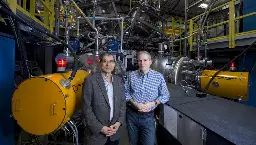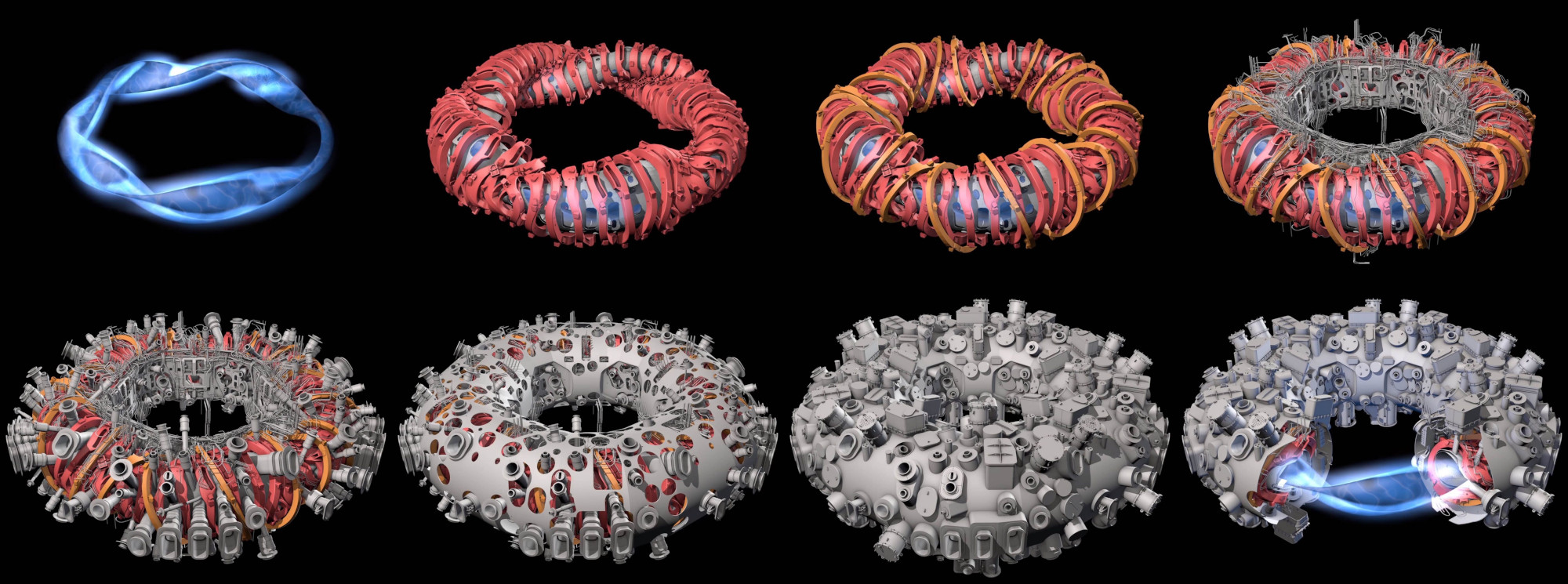
- www.livescience.com World's largest nuclear fusion reactor is finally completed. But it won't run for another 15 years.
ITER, a $28 billion fusion reactor in France, has finally had its last magnetic coil installed. But the reactor itself won't fire up fully until 2039 at the earliest.
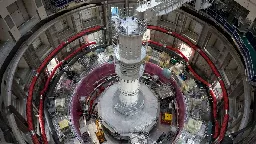
-
W7-X new record: Plasma with gigajoule energy turnover generated for eight minutes via average coupled heating power of 2.7 megawatts
phys.org Power plasma with gigajoule energy turnover generated for eight minutesAfter successful recommissioning in autumn 2022, the Greifswald nuclear fusion experiment has surpassed an important target. In 2023, an energy turnover of 1 gigajoule was targeted. Now the researchers have even achieved 1.3 gigajoules and a new record for discharge time on Wendelstein 7-X: the hot ...
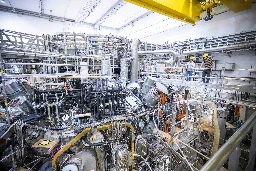
> On 15 February 2023, the researchers reached a new milestone: for the first time, they were able to achieve an energy turnover of 1.3 gigajoules in this device. This was 17 times higher than the best value achieved before the conversion (75 megajoules). The energy turnover results from the coupled heating power multiplied by the duration of the discharge. Only if it is possible to couple large amounts of energy continuously into the plasma and also remove the resulting heat, a power plant operation is possible.
> The energy turnover of 1.3 gigajoule was achieved with an average heating power of 2.7 megawatts, whereby the discharge lasted 480 seconds. This is also a new record for Wendelstein 7-X and one of the best values worldwide. Before the completion works, Wendelstein 7-X achieved maximum plasma times of 100 seconds at much lower heating power.
> Within a few years, the plan is to increase the energy turnover at Wendelstein 7-X to 18 gigajoules, with the plasma then being kept stable for half an hour.
-
Fusion ignition (aka energy breakeven) has been achieved
www.energy.gov DOE National Laboratory Makes History by Achieving Fusion IgnitionThe U.S. Department of Energy (DOE) and DOE’s National Nuclear Security Administration (NNSA) today announced the achievement of fusion ignition at Lawrence Livermore National Laboratory (LLNL)—a major scientific breakthrough decades in the making.
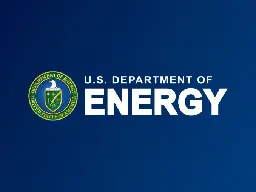
-
Improved Stellarator Coil System compared to Wendelstein 7-x (cambridge.org) | A single-field-period quasi-isodynamic stellarator | Journal of Plasma Physics | Cambridge Core

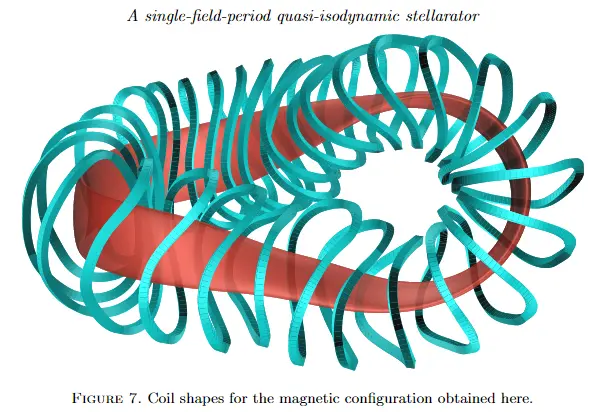
https://www.cambridge.org/core/journals/journal-of-plasma-physics/article/abs/singlefieldperiod-quasiisodynamic-stellarator/9B2A5FDCCD7774E4F91BE45E75FDC6B0
> A single-field-period quasi-isodynamic stellarator configuration is presented. This configuration, which resembles a twisted strip, is obtained by the method of direct construction, that is, it is found via an expansion in the distance from the magnetic axis. Its discovery, however, relied on an additional step involving numerical optimization, performed within the space of near-axis configurations defined by a set of adjustable magnetic field parameters. This optimization, completed in 30 s on a single CPU core using the SIMSOPT code, yields a solution with excellent confinement, as measured by the conventional figure of merit for neoclassical transport, effective ripple, at a modest aspect ratio of eight. The optimization parameters that led to this configuration are described, its confinement properties are assessed and a set of magnetic field coils is found. The resulting transport at low collisionality is much smaller than that of W7-X, and the device needs significantly fewer coils because of the reduced number of field periods.
https://arxiv.org/abs/2205.05797 https://arxiv.org/pdf/2205.05797.pdf
-
More invested in nuclear fusion in last 12 months than past decade
www.growthbusiness.co.uk More invested in nuclear fusion in last 12 months than past decade - Growth BusinessNuclear fusion has attracted £2.5bn in investment globally over the past year, compared with £1.6bn in total over the past decade.

-
ITER Blanket Shield Module - Episode 1 of "ITER - How It Works" Series
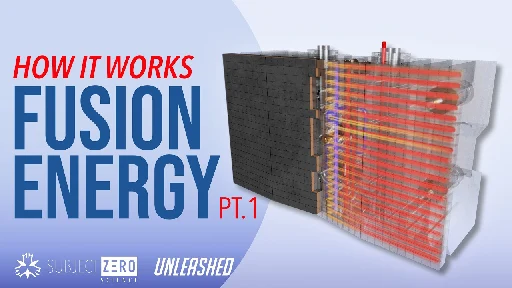
YouTube Video
Click to view this content.
-
Optimized compact stellarator with only 4 simple coils | Cambridge, 23 May 2022
www.cambridge.org Existence of an optimized stellarator with simple coils | Journal of Plasma Physics | Cambridge CoreExistence of an optimized stellarator with simple coils - Volume 88 Issue 3
An optimized compact stellarator with four simple coils is obtained from direct optimization via a coil shape. The new stellarator consists of two interlocking coils and two vertical field coils similar to those of the Columbia Non-neutral Torus (CNT) (Pedersen et al., Phys. Rev. Lett., vol. 88, 2002, pp. 205002). The optimized configuration has a global magnetic well and a low helical ripple level comparable to that of Wendelstein 7-X (W7-X) (Wolf et al., Nucl. Fusion, vol. 57, 2017, pp. 102020). The two interlocking coils have a smooth three-dimensional shape much simpler than those of advanced stellarators such as W7-X. This result opens up possibilities of future stellarator reactors with simplified coils.
- www.livescience.com Physicists just rewrote a foundational rule for nuclear fusion reactors that could unleash twice the power
Fusion reactors could generate more power thanks to a reworking of Greenwald's Law.
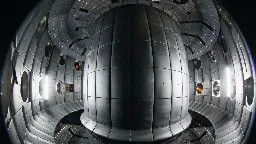
Fusion reactors could generate more power thanks to a reworking of Greenwald's Law.
The research, led by physicists from the Swiss Plasma Center at École Polytechnique Fédérale de Lausanne (EFPL), has determined that the maximum hydrogen fuel density is about twice the “Greenwald Limit” – an estimate derived from experiments more than 30 years ago.
A study about the discovery was published May 6 in the journal Physical Review Letters.
